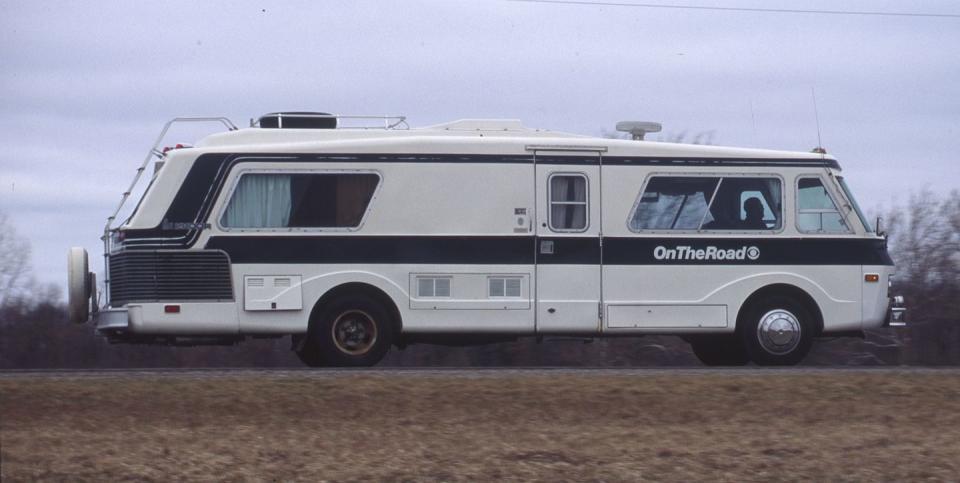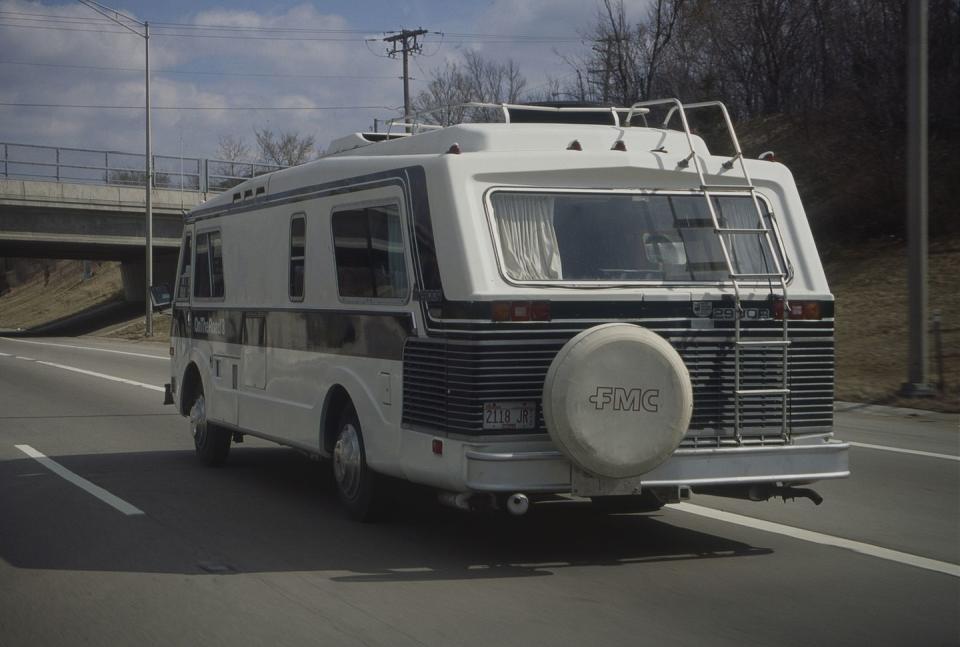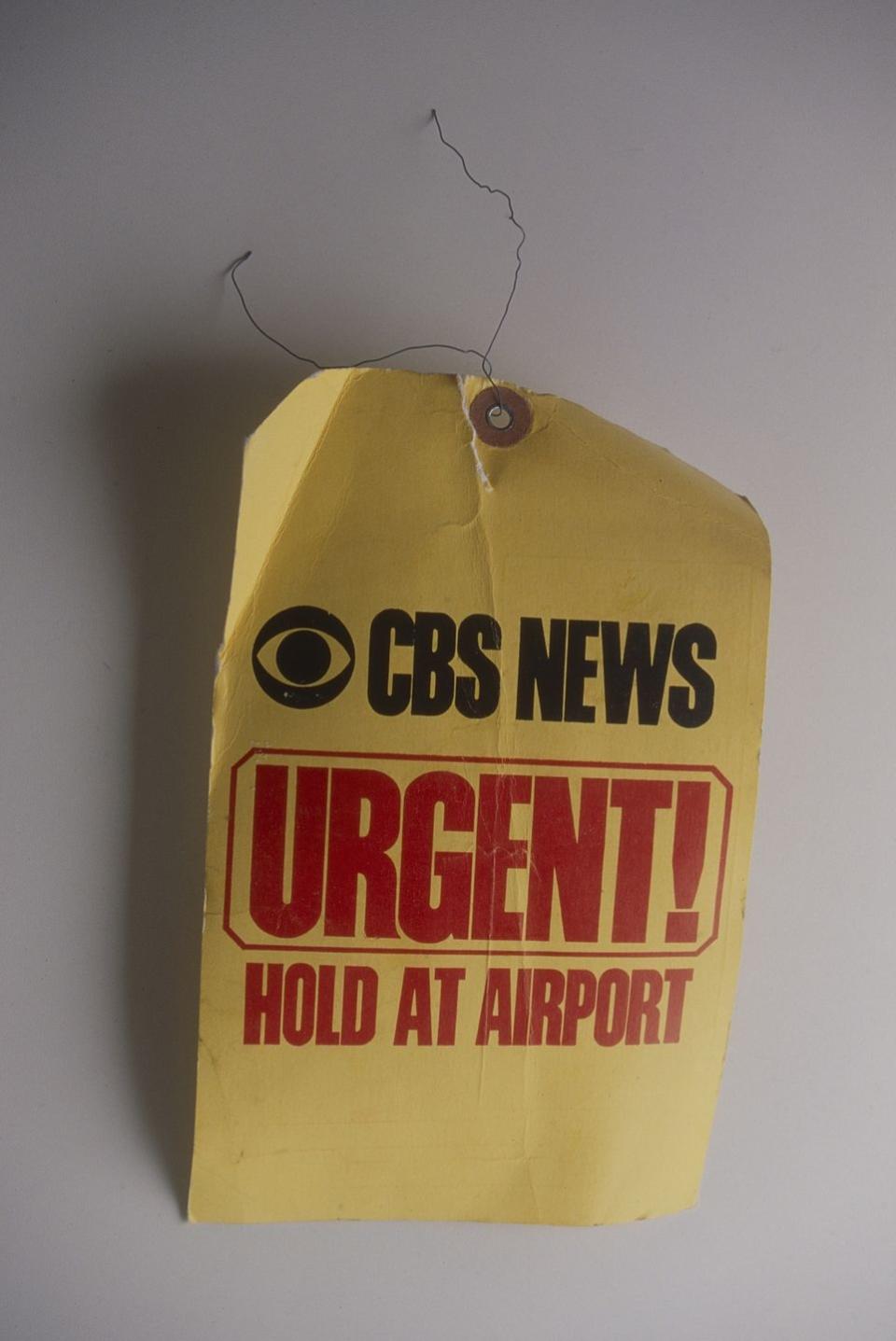From the Archive: Travels with Charles Kuralt, Who Chronicled America from the Road

From the July 1995 issue of Car and Driver.
Of all the mixed blessings and curses of my life, I put motorhomes at the top of the list. —Charles Kuralt
The TWA tag on the faux leather flight bag says: "Property Charles Kuralt, 34 Bank Street, NY, NY, 10014." Inside the bag, I find: one khaki safari shirt, one pair of slacks with suspenders, one woolen pullover from Saks Fifth Avenue (size XL), one pair of Wallabees with felt insole liners (size 12), one pair of long underwear (bottoms only), two pairs of gloves, one knit cap, a typed list of CBS affiliates, a bottle of Murine, an "Ear Wax Removal System," plus a booklet intended to accompany a Smith Corona 8000 typewriter. Here is its title: Rules for Safe Operation.
Not far from Kuralt's bag is another book: Jack London's The Call of the Wild. It was checked out of a library seven years ago, when Kuralt was last aboard this ratty 1973 FMC 2900R motorhome, videotaping segments for the television show On the Road. The motorhome was parked in 1988, but its contents were left undisturbed in case the CBS team opted to return. Criminal proceedings may now attend the library book's long overdue return.

Rifling through Charles Kuralt's personal effects, I felt like a voyeur, a scopophiliac. But I had to find out. Kuralt, now 60, began his career as a correspondent in 1957. He has never stopped traveling, not even after his retirement from CBS a year ago. Just what, precisely, does a man pack if he has no fixed address and expects to roam America randomly in motorhomes for 20 consecutive years?
My curiosity was sated courtesy of subscriber and BMW-phile Tom Goodman, who is a CBS vice-president. Goodman asked if Car and Driver wanted to drive Kuralt's On the Road coach from Chicago (where it was last parked) to Dearborn, Michigan, where the white behemoth would be put to perpetual rest in the Henry Ford Museum. The trip would be the vehicle's last drum roll through small-town America—this after Kuralt, cameraman Isadore "Izzy" Bleckman, and soundman Larry Giarmeschi had logged more than one million motorhome miles throughout 48 states. In total, the threesome recorded some 500 On the Road TV segments, many recently edited into 60 half-hour shows for the Travel Channel.

As it turns out, Kuralt and his CBS colleagues used up six motorhomes: two Travcos, two Cortezes, one Revcon, and the FMC shown here. "The first bus—we never called them motorhomes—was the Travco acquired in the fall of 1967," says Kuralt. "It didn't even belong to CBS. We rented it from the National Geographic Society.
"[It] was a Dodge truck chassis perilously supporting a fiberglass body—a pink box that swayed alarmingly when underway. The second [Travco] was purchased with CBS's money, and we painted it white."
Cameraman "Izzy" Bleckman, now 59, the man who unwittingly became the team's mechanic, chose the third bus. It was a Cortez, and Izzy was usually at the wheel. He grew a mustache to emulate his hero, British F1 driver Graham Hill. "Izzy owned sports cars," says Kuralt, "and he was a good driver, the Juan Manuel Fangio of motorhomes. It was okay with me that he usually drove because it left me to sit at the bus's desk and think."
The trio's love/hate affair with the Cortez lasted nearly a decade, although the "hate" component of the equation eventually achieved dominance. "Its metal body was way too heavy for the flimsy chassis and suspension," recalls Kuralt in his book, A Life on the Road. "What was a bump in the road to others was probably a blowout or broken wheel to us. In California redwood country one Sunday, I glanced into the mirror to notice that we were trailing smoke and fire . . . the rear wheel bearings had welded themselves to the rear axles."
After the second Cortez attained terminal mechanical decrepitude, Kuralt discovered "that the company had gone broke and was blessedly unable to provide a third. We bought a brand-new Revcon," Kuralt recalls, "an elegantly appointed product of California. This was my idea. I liked the thick carpet."
Bleckman regarded the Revcon with fear and loathing. "You know, if Charles were a woman, he'd be pregnant all the time," he says. "Charles always says yes." When the gleaming new Revcon first appeared, Kuralt asked Izzy, "What do you think?"
"I think every moving part is going to break down," Izzy replied."We bought it anyway," said Kuralt.
"Every moving part broke down."
That debacle led to the purchase of the FMC 2900R shown here, the last and most celebrated of the six On the Road buses. Kuralt's introduction to it, however, was grim. "The first time we turned on the windshield wipers," he says, "one of them flew off and vanished into the storm." Nonetheless, it is this motorhome that Charles, Izzy, and Larry drove 240,000 miles. Which is nearly the distance from Earth to the moon, or, in the case of On the Road, a distance equal to the most circuitous route from Cumby, Texas, to Lookingglass, Oregon, to the Holly Shelter Swamp in North Carolina, near Kuralt's birthplace. Interspersed were unplanned diversionary meetings with Esther Wright ("the Bird Lady of St. Petersburg"), Hunter Thompson, MarIon Brando (who said to Kuralt, "If you leave this town before I catch a fish, you scum, I will find you wherever you are and kill you with my own hands"), Pete Seeger, Andrew Wyeth, and Jim Rozier. Rozier rubs truck springs across wooden stakes, which somehow causes earthworms to leap into his fingers.
Apart from two CBS eyeball logos and a largish TV antenna, the exterior of the FMC is remarkable only for its grotesque trapezoidal shape and its unremitting ungainliness—it's 8.5 feet tall and almost 30 feet long. It is powered by a 440-cubic-inch Chrysler V-8 tucked cater-cornered behind the right-rear wheels. Without Izzy Bleckman's cameras and tripods, without Kuralt's typewriter and on-camera wardrobe, without microphones and reflectors and hundreds of feet of extension cords, the motorhome weighs 12,500 pounds. On the road, however, ready to record the dazzlingly simple stories of mainstream America and with three Egg McMuffin–fed men aboard, the bus usually out-larded its GVW of 14,500 pounds and wreaked inestimable carnage on its 17-inch tires.

"What I remember most clearly of life on the road was shredding tires," Bleckman recalls. "And they were sometimes hard to replace. I once called Goodyear to find a stash. The guy asked how much the bus weighed. When I told him, he went quiet for a few beats, then said slowly: 'Do not under any circumstances drive that thing on our tires. We can't be responsible. We don't want to even hear what happens.'"
"We experienced four spectacular blowouts in May '74 alone," Kuralt recalls. "In Ohio, both rear tires blew at once. The [motorhome] descended upon its rear springs at 60 mph, sending up a rooster tail of sparks for a quarter-mile . . ."
During Car and Driver's stint behind the FMC 2900R's wheel, from Chicago to Dearborn, we quickly learned that you don't so much drive the thing as shepherd it. It wanders constantly from berm to center stripe, with six inches of free play in the sloppy Saginaw steering. Looking like Ralph Kramden perched above his bus wheel, I developed a blister on my right palm before I realized that corrections were a waste of time; the FMC usually returns to a straight-ahead tack if you are simply patient. While you're waiting, you also learn to cope with the world's worst throttle response, acceleration that can be measured only with a day timer, and braking so poor that the driver must be skilled at predicting events that might transpire 30 to 60 seconds in the future.

 Yahoo Autos
Yahoo Autos 